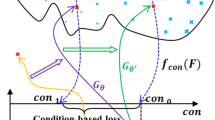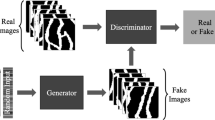Abstract
Geological facies modeling has long been studied to predict subsurface resources. In recent years, generative adversarial networks (GANs) have been used as a new method for geological facies modeling with surprisingly good results. However, in conventional GANs, all layers are trained concurrently, and the scales of the geological features are not considered. In this study, we propose to train GANs for facies modeling based on a new training process, namely progressive growing of GANs or a progressive training process. In the progressive training process, GANs are trained layer by layer, and geological features are learned from coarse scales to fine scales. We also train a GAN in the conventional training process, and compare the conventionally trained generator with the progressively trained generator based on visual inspection, multi-scale sliced Wasserstein distance (MS-SWD), multi-dimensional scaling (MDS) plot visualization, facies proportion, variogram, and channel sinuosity, width, and length metrics. The MS-SWD reveals realism and diversity of the generated facies models, and is combined with MDS to visualize the relationship between the distributions of the generated and training facies models. The conventionally and progressively trained generators both have very good performances on all metrics. The progressively trained generator behaves especially better than the conventionally trained generator on the MS-SWD, MDS plots, and the necessary training time. The training time for the progressively trained generator can be as small as 39% of that for the conventionally trained generator. This study demonstrates the superiority of the progressive training process over the conventional one in geological facies modeling, and provides a better option for future GAN-related researches.
Similar content being viewed by others
References
Pyrcz, M.J., Deutsch, C. V.: Geoestatistical Reservoir Modeling. (2014)
Mariethoz, G., Caers, J.: Multiple-Point Geostatistics: Stochastic Modeling with Training Images. (2014)
Zuo, C., Yin, Z., Pan, Z., MacKie, E.J., Caers, J.: A tree-based direct sampling method for stochastic surface and subsurface hydrological modeling. Water Resour. Res. 56, (2020). https://doi.org/10.1029/2019WR026130
Yan, N., Mountney, N.P., Colombera, L., Dorrell, R.M.: A 3D forward stratigraphic model of fluvial meander-bend evolution for prediction of point-bar lithofacies architecture. Comput. Geosci. 105, 65–80 (2017). https://doi.org/10.1016/j.cageo.2017.04.012
Tahmasebi, P., Kamrava, S., Bai, T., Sahimi, M.: Machine Learning in Geo- and Environmental Sciences: from Small to Large Scale, (2020)
Avalos, S., Ortiz, J.M.: Recursive convolutional neural networks in a multiple-point statistics framework. Comput. Geosci. 141, 104522 (2020). https://doi.org/10.1016/j.cageo.2020.104522
Ian Goodfellow, Yoshua Bengio, A.C.: Deep Learning. (2015)
Gan, Z., Henao, R., Carlson, D., Carin, L.: Learning Deep Sigmoid Belief Networks with Data Augmentation. In: Journal of Machine Learning Research (2015)
Larochelle, H., Murray, I.: The Neural Autoregressive Distribution Estimator. In: Proceedings of the 14th International Conference on Artificial Intelligence and Statistics (AISTATS 2011) (2011)
Van Den Oord, A., Kalchbrenner, N., Vinyals, O., Espeholt, L., Graves, A., Kavukcuoglu, K.: Conditional Image Generation with PixelCNN Decoders. In: Advances in Neural Information Processing Systems (2016)
Rezende, D.J., Mohamed, S., Wierstra, D.: Stochastic backpropagation and approximate inference in deep generative models. In: 31st Int;ernational Conference on Machine Learning, ICML 2014 (2014)
Goodfellow, I., Pouget-Abadie, J., Mirza, M., Xu, B., Warde-Farley, D., Ozair, S., Courville, A., Bengio, Y.: Generative Adversarial Networks. In: Advances in Neural Information Processing Systems 27 (2014)
Radford, A., Metz, L., Chintala, S.: Unsupervised Representation Learning with Deep Convolutional Generative Adversarial Networks. arXiv e-prints. arXiv:1511.06434 (2015)
Arjovsky, M., Chintala, S., Bottou, L.: Wasserstein GAN. arXiv e-prints. arXiv:1701.07875 (2017)
Gulrajani, I., Ahmed, F., Arjovsky, M., Dumoulin, V., Courville, A.: Improved Training of Wasserstein GANs. arXiv e-prints. arXiv:1704.00028 (2017)
Zhu, J.Y., Park, T., Isola, P., Efros, A.A.: Unpaired Image-to-Image Translation Using Cycle-Consistent Adversarial Networks. In: Proceedings of the IEEE International Conference on Computer Vision (2017)
Karras, T., Aila, T., Laine, S., Lehtinen, J.: Progressive Growing of GANs for Improved Quality, Stability, and Variation. arXiv e-prints. arXiv:1710.10196 (2017)
Karras, T., Laine, S., Aila, T.: A Style-Based Generator Architecture for Generative Adversarial Networks. arXiv e-prints. arXiv:1812.04948 (2018)
Dumoulin, V., Belghazi, I., Poole, B., Mastropietro, O., Lamb, A., Arjovsky, M., Courville, A.: Adversarially Learned Inference. arXiv e-prints. arXiv:1606.00704 (2016)
Van Den Oord, A., Dieleman, S., Zen, H., Simonyan, K., Vinyals, O., Graves, A., Kalchbrenner, N., Senior, A., Kavukcuoglu, K.: WaveNet: A Generative Model for Raw Audio. arXiv e-prints. arXiv:1609.03499 (2016)
Ledig, C., Theis, L., Huszar, F., Caballero, J., Cunningham, A., Acosta, A., Aitken, A., Tejani, A., Totz, J., Wang, Z., Shi, W.: Photo-Realistic Single Image Super-Resolution Using a Generative Adversarial Network. arXiv e-prints. arXiv:1609.04802 (2016)
Reed, S., Akata, Z., Yan, X., Logeswaran, L., Schiele, B., Lee, H.: Generative Adversarial Text to Image Synthesis. arXiv e-prints. arXiv:1605.05396 (2016)
Isola, P., Zhu, J.-Y., Zhou, T., Efros, A.A.: Image-to-Image Translation with Conditional Adversarial Networks. arXiv e-prints. arXiv:1611.07004 (2016)
Laloy, E., Hérault, R., Lee, J., Jacques, D., Linde, N.: Inversion using a new low-dimensional representation of complex binary geological media based on a deep neural network. Adv. Water Resour. 110, 387–405 (2017). https://doi.org/10.1016/j.advwatres.2017.09.029
Mosser, L., Dubrule, O., Blunt, M.J.: Reconstruction of three-dimensional porous media using generative adversarial neural networks. Phys. Rev. E. 96, (2017). https://doi.org/10.1103/PhysRevE.96.043309
Mosser, L., Dubrule, O., Blunt, M.J.: Stochastic reconstruction of an Oolitic limestone by generative adversarial networks. Transp. Porous Media. 125, 81–103 (2018). https://doi.org/10.1007/s11242-018-1039-9
Chan, S., Elsheikh, A.H.: Parametrization and generation of geological models with generative adversarial networks, (2017)
Wu, J., Zhang, C., Xue, T., Freeman, W.T., Tenenbaum, J.B.: Learning a Probabilistic Latent Space of Object Shapes via 3D Generative-Adversarial Modeling. arXiv e-prints. arXiv:1610.07584 (2016)
Zhang, T.F., Tilke, P., Dupont, E., Zhu, L.C., Liang, L., Bailey, W.: Generating geologically realistic 3D reservoir facies models using deep learning of sedimentary architecture with generative adversarial networks. Pet. Sci. 16, 541–549 (2019). https://doi.org/10.1007/s12182-019-0328-4
Mogren, O.: C-RNN-GAN: Continuous recurrent neural networks with adversarial training. arXiv e-prints. arXiv:1611.09904 (2016)
Ma, L., Jia, X., Sun, Q., Schiele, B., Tuytelaars, T., Van Gool, L.: Pose Guided Person Image Generation. arXiv e-prints. arXiv:1705.09368 (2017)
Zhang, H., Xu, T., Li, H., Zhang, S., Wang, X., Huang, X., Metaxas, D.: StackGAN: Text to Photo-realistic Image Synthesis with Stacked Generative Adversarial Networks. arXiv e-prints. arXiv:1612.03242 (2016)
Lucic, M., Kurach, K., Michalski, M., Gelly, S., Bousquet, O.: Are GANs Created Equal? A Large-Scale Study. arXiv e-prints. arXiv:1711.10337 (2017)
Tran, T.T.: Improving variogram reproduction on dense simulation grids. Comput. Geosci. 20, 1161–1168 (1994). https://doi.org/10.1016/0098-3004(94)90069-8
Strebelle, S.: Conditional simulation of complex geological structures using multiple-point statistics. Math. Geol. 34, 1–21 (2002). https://doi.org/10.1023/A:1014009426274
Liu, Y.: Using the Snesim program for multiple-point statistical simulation. Comput. Geosci. 32, 1544–1563 (2006). https://doi.org/10.1016/j.cageo.2006.02.008
Arpat, G.B., Caers, J.: Conditional simulation with patterns. Math. Geol. 39, 177–203 (2007). https://doi.org/10.1007/s11004-006-9075-3
He, K., Zhang, X., Ren, S., Sun, J.: Delving Deep into Rectifiers: Surpassing Human-Level Performance on ImageNet Classification. In: IEEE International Conference on Computer Vision. pp. 1026–1034 (2015)
Kingma, D., Ba, J.: Adam: a method for stochastic optimization. arXiv Prepr. arXiv1412.6980. (2014). https://doi.org/10.1109/ICCE.2017.7889386
Borji, A.: Pros and Cons of GAN Evaluation Measures. arXiv e-prints. arXiv:1802.03446 (2018)
Wang, Z., Simoncelli, E.P., Bovik, A.C.: Multiscale structural similarity for image quality assessment. In: The Thrity-Seventh Asilomar Conference on Signals, Systems & Computers, 2003. pp. 1398–1402 (2003)
Mosser, L., Dubrule, O., Blunt, M.J.: Stochastic seismic waveform inversion using generative adversarial networks as a geological prior. Math. Geosci. 52, 53–79 (2020). https://doi.org/10.1007/s11004-019-09832-6
Zhong, Z., Sun, A.Y., Jeong, H.: Predicting CO 2 plume migration in heterogeneous formations using conditional deep convolutional generative adversarial network. Water Resour. Res. 55, 5830–5851 (2019). https://doi.org/10.1029/2018wr024592
Burt, P.J., Adelson, E.H.: Readings in Computer Vision: Issues, Problems, Principles, and Paradigms. Presented at the (1987)
Rabin, J., Peyré, G., Delon, J., Bernot, M.: Wasserstein barycenter and its application to texture mixing. In: Bruckstein, A.M., ter Haar Romeny, B.M., Bronstein, A.M., and Bronstein, M.M. (eds.) Scale Space and Variational Methods in Computer Vision. pp. 435–446. Springer Berlin Heidelberg, Berlin, Heidelberg (2012)
Scheidt, C., Caers, J.: Representing spatial uncertainty using distances and kernels. Math. Geosci. 41, 397–419 (2009). https://doi.org/10.1007/s11004-008-9186-0
Azevedo, L., Paneiro, G., Santos, A., Soares, A.: Generative adversarial network as a stochastic subsurface model reconstruction. Comput. Geosci. 24, 1673–1692 (2020). https://doi.org/10.1007/s10596-020-09978-x
Laloy, E., Hérault, R., Jacques, D., Linde, N.: Training-image based Geostatistical inversion using a spatial generative adversarial neural network. Water Resour. Res. 54, 381–406 (2018). https://doi.org/10.1002/2017WR022148
Nesvold, E., Mukerji, T.: Geomodeling Using Generative Adversarial Networks and a Database of Satellite Imagery of Modern River Deltas. In: Petroleum Geostatistics (2019)
Acknowledgments
This work was supported by the National Natural Science Foundation of China (42072146). We acknowledge the sponsors of the Stanford Center for Earth Resources Forecasting (SCERF) and support from Prof. Steve Graham, the Dean of the Stanford School of Earth, Energy and Environmental Sciences. Some of the computing for this project was performed on the Sherlock cluster at Stanford University. We would like to thank Stanford University and the Stanford Research Computing Center for providing computational resources and support that contributed to these research results. Codes, data, and some results of this work are available at the GitHub site (https://github.com/SuihongSong/GeoModeling_Unconditional_ProGAN).
Author information
Authors and Affiliations
Corresponding author
Additional information
Publisher’s note
Springer Nature remains neutral with regard to jurisdictional claims in published maps and institutional affiliations.
Key Points
• Progressive growing of GANs is used for geological facies modeling, where geological features are learned from large scales to fine scales.
• Multi-scale sliced Wasserstein distance, multi-dimensional scaling plot, facies proportion, variogram, and channel sinuosity, width, and length are proposed as metrics to evaluate GANs.
• Progressive growing of GANs behaves better than conventional training processes in many metrics including computation time.
Rights and permissions
About this article
Cite this article
Song, S., Mukerji, T. & Hou, J. Geological Facies modeling based on progressive growing of generative adversarial networks (GANs). Comput Geosci 25, 1251–1273 (2021). https://doi.org/10.1007/s10596-021-10059-w
Received:
Accepted:
Published:
Issue Date:
DOI: https://doi.org/10.1007/s10596-021-10059-w




